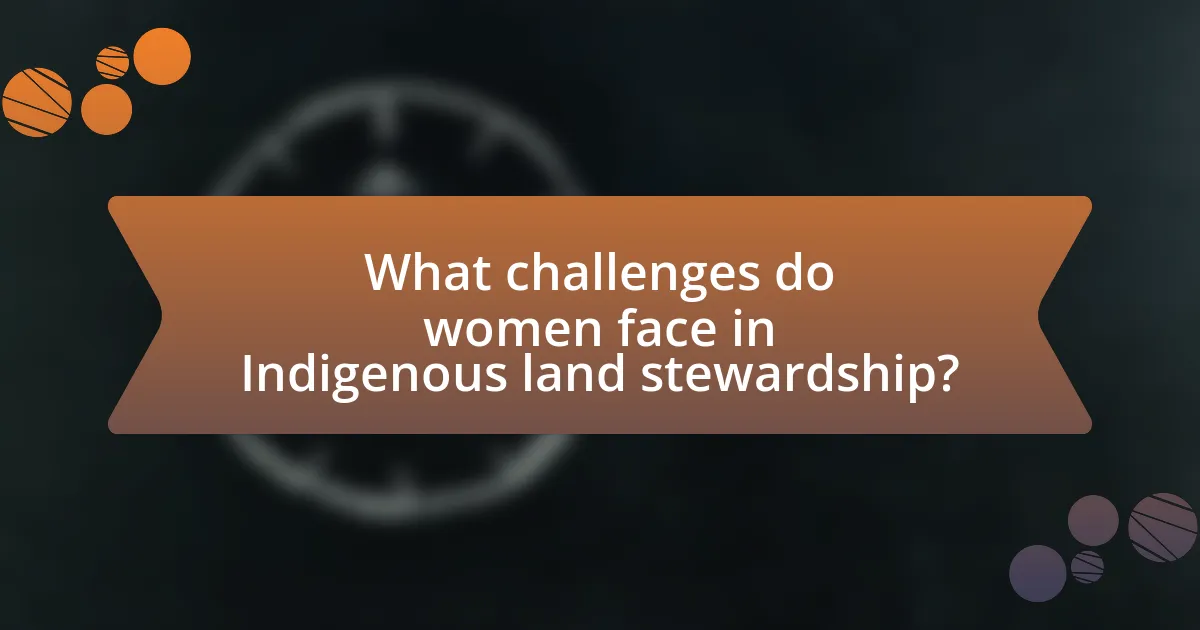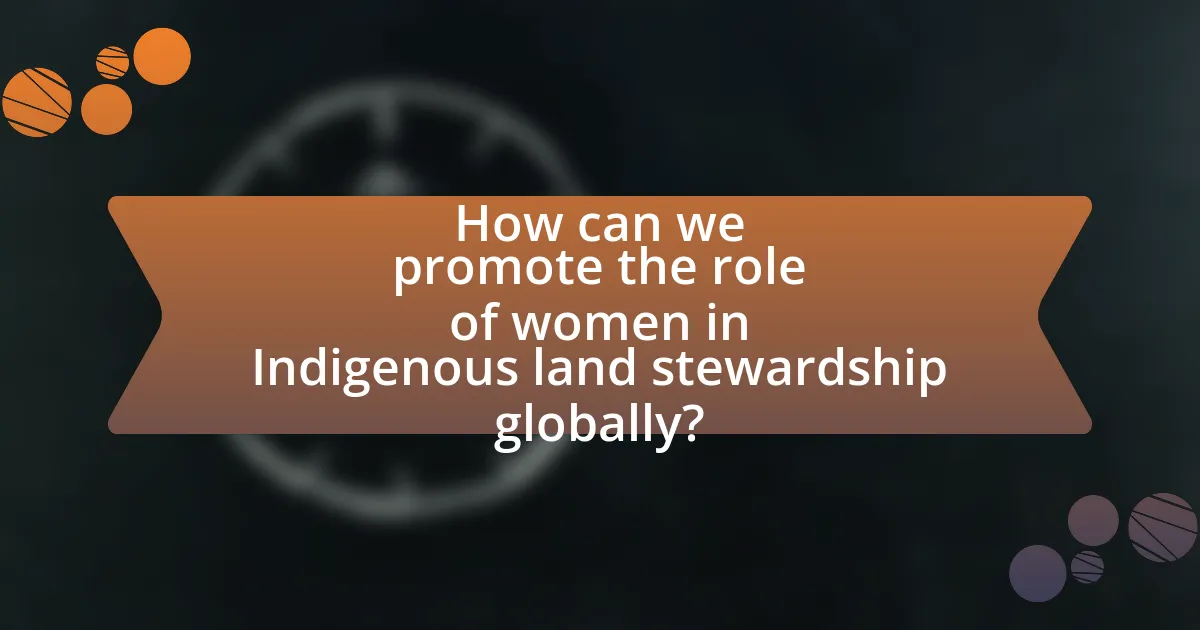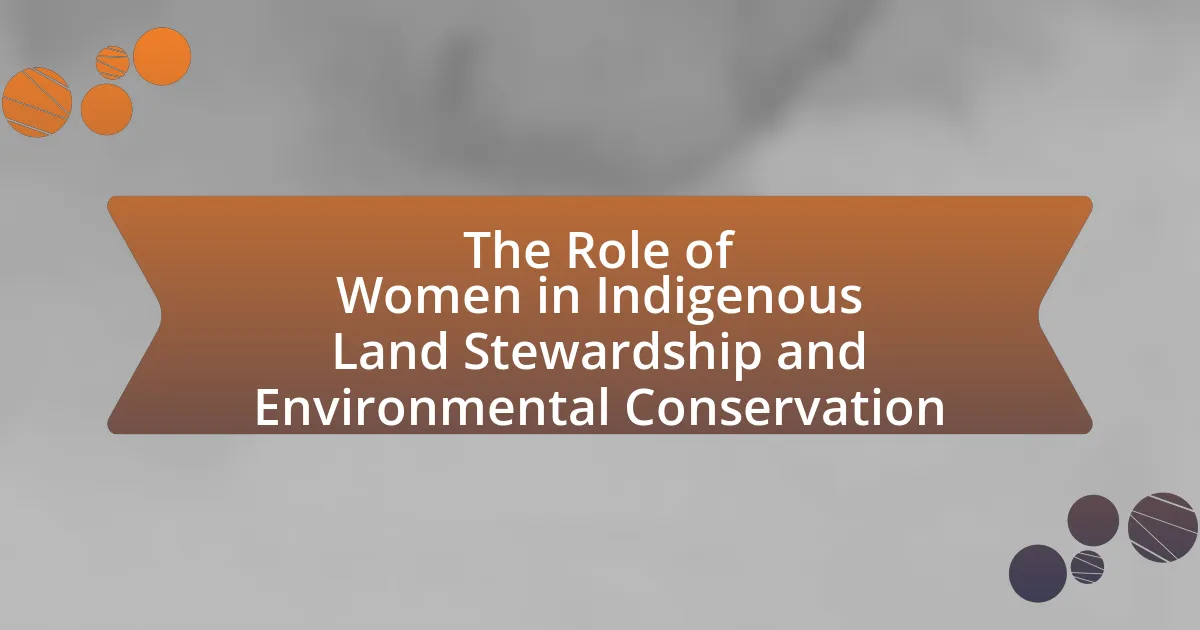The article examines the critical role of women in Indigenous land stewardship and environmental conservation, highlighting their contributions as knowledge holders, decision-makers, and active participants in sustainable practices. It discusses how women possess traditional ecological knowledge essential for managing local ecosystems and resources, and how their involvement leads to more effective conservation outcomes. The article also addresses the challenges women face, including systemic discrimination and socio-economic barriers, while proposing strategies to empower them through education, community support, and policy changes. Additionally, it emphasizes the importance of recognizing women’s contributions globally to enhance environmental stewardship and biodiversity management.

What is the Role of Women in Indigenous Land Stewardship and Environmental Conservation?
Women play a crucial role in Indigenous land stewardship and environmental conservation by serving as knowledge holders, decision-makers, and active participants in sustainable practices. They are often the primary custodians of traditional ecological knowledge, which includes understanding local ecosystems, biodiversity, and sustainable resource management. Research indicates that women in Indigenous communities frequently lead initiatives aimed at preserving natural resources and advocating for environmental justice, as seen in various case studies across North America and Australia. For instance, the United Nations has recognized the importance of women’s involvement in environmental governance, highlighting that their participation leads to more effective conservation outcomes. This evidence underscores the significant impact women have in fostering sustainable practices and protecting Indigenous lands.
How do women contribute to Indigenous land stewardship practices?
Women contribute to Indigenous land stewardship practices by serving as key knowledge holders and decision-makers in sustainable resource management. Their roles often include the transmission of traditional ecological knowledge, which encompasses practices related to agriculture, foraging, and conservation that have been passed down through generations. For instance, studies have shown that women are frequently responsible for managing community gardens and medicinal plant harvesting, which are vital for both cultural identity and ecological health. Additionally, women often lead initiatives that advocate for environmental protection and sustainable practices, thereby influencing community policies and practices. This involvement is supported by research indicating that communities with active female participation in land management tend to exhibit more sustainable outcomes, as highlighted in the report “Gender and Land Rights in the Context of Climate Change” by the Food and Agriculture Organization.
What traditional knowledge do women bring to environmental conservation?
Women contribute traditional knowledge to environmental conservation through their understanding of local ecosystems, sustainable resource management, and biodiversity preservation. This knowledge is often passed down through generations and includes practices such as crop rotation, medicinal plant use, and water conservation techniques. For instance, studies have shown that women in various indigenous communities possess detailed knowledge about native plant species and their ecological roles, which is crucial for maintaining biodiversity. Additionally, women’s roles in community decision-making often lead to more sustainable environmental practices, as they prioritize the health of their families and communities. This traditional ecological knowledge is recognized by organizations like the United Nations as vital for effective conservation strategies.
How do women’s roles differ across various Indigenous cultures?
Women’s roles differ significantly across various Indigenous cultures, often shaped by unique social structures, traditions, and environmental contexts. For instance, in many matrilineal societies, such as the Haudenosaunee (Iroquois), women hold substantial power in decision-making processes, particularly regarding land use and resource management. Conversely, in some patrilineal cultures, women’s roles may be more focused on domestic responsibilities, with limited involvement in public decision-making.
Additionally, the role of women in environmental stewardship varies; for example, among the Navajo, women are traditionally responsible for agricultural practices and the management of natural resources, reflecting their integral role in sustaining community livelihoods. In contrast, among the Sami people of Northern Europe, women often engage in reindeer herding and cultural preservation, showcasing their contributions to both environmental conservation and cultural identity.
These variations highlight the diverse ways in which Indigenous cultures recognize and empower women, influencing their participation in land stewardship and environmental conservation efforts.
Why is women’s involvement crucial in environmental conservation efforts?
Women’s involvement is crucial in environmental conservation efforts because they play a key role in sustainable resource management and biodiversity preservation. Research indicates that women, particularly in indigenous communities, possess traditional ecological knowledge that is vital for effective land stewardship. For instance, a study published in the journal “Environmental Science & Policy” highlights that women often manage household resources and are primary caregivers, giving them unique insights into local ecosystems and sustainable practices. Furthermore, data from the United Nations shows that when women are included in decision-making processes related to environmental policies, the outcomes are more effective and equitable, leading to improved conservation results.
What impact do women have on biodiversity and ecosystem management?
Women significantly impact biodiversity and ecosystem management through their roles as knowledge holders, decision-makers, and active participants in conservation efforts. Research indicates that women often possess unique traditional ecological knowledge that contributes to sustainable practices and biodiversity conservation. For instance, a study published in the journal “Environmental Science & Policy” highlights that women in indigenous communities are crucial in managing natural resources, leading to improved ecosystem health and resilience. Their involvement in land stewardship not only enhances biodiversity but also promotes sustainable agricultural practices, as evidenced by the Food and Agriculture Organization’s findings that women’s participation in agriculture can lead to increased crop diversity and improved food security.
How does women’s leadership influence community conservation initiatives?
Women’s leadership significantly enhances community conservation initiatives by fostering inclusive decision-making and promoting sustainable practices. Research indicates that women often prioritize environmental health and community well-being, leading to more effective conservation outcomes. For instance, a study published in the journal “Nature Sustainability” found that communities led by women are more likely to implement successful conservation strategies, as women tend to engage in collaborative approaches that consider diverse perspectives and local knowledge. This inclusive leadership style not only strengthens community ties but also improves the resilience of ecosystems, demonstrating the critical role women play in advancing environmental conservation efforts.

What challenges do women face in Indigenous land stewardship?
Women in Indigenous land stewardship face several challenges, including systemic discrimination, limited access to resources, and cultural barriers. Systemic discrimination often manifests in legal frameworks that do not recognize women’s rights to land and resources, undermining their authority in stewardship roles. Limited access to financial resources and training further hampers their ability to engage effectively in land management practices. Cultural barriers may include traditional gender roles that restrict women’s participation in decision-making processes related to land use and environmental conservation. These challenges are documented in studies such as “Indigenous Women and Land: A Global Perspective” by the United Nations, which highlights the need for inclusive policies that empower women in these critical roles.
How do socio-economic factors affect women’s roles in environmental conservation?
Socio-economic factors significantly influence women’s roles in environmental conservation by determining their access to resources, education, and decision-making power. Women in lower socio-economic conditions often face barriers that limit their participation in conservation efforts, such as lack of financial resources, limited access to education, and restricted rights to land ownership. For instance, a study by the Food and Agriculture Organization (FAO) found that women play a crucial role in managing natural resources, yet their contributions are often undervalued due to socio-economic constraints. Additionally, women with higher socio-economic status tend to have greater access to networks and information, enabling them to engage more effectively in environmental initiatives. This disparity highlights the need for targeted policies that address socio-economic inequalities to enhance women’s involvement in environmental conservation.
What barriers exist for women in accessing land and resources?
Barriers for women in accessing land and resources include legal restrictions, cultural norms, and economic challenges. Legal frameworks in many regions often favor male ownership, limiting women’s rights to inherit or own land. Cultural norms frequently dictate that land is a male domain, discouraging women’s participation in land management and decision-making. Additionally, economic challenges such as lack of access to credit and financial resources hinder women’s ability to invest in land or agricultural activities. According to the Food and Agriculture Organization, women represent only 13% of landholders globally, highlighting the systemic inequalities that persist in land access.
How do cultural perceptions impact women’s participation in stewardship activities?
Cultural perceptions significantly impact women’s participation in stewardship activities by shaping societal norms and expectations regarding gender roles. In many cultures, traditional views may limit women’s access to decision-making processes and leadership roles in environmental conservation, thereby reducing their involvement in stewardship activities. For instance, a study by the United Nations Environment Programme highlights that in communities where women are viewed primarily as caregivers, their contributions to land management and conservation efforts are often undervalued, leading to lower participation rates. Additionally, cultural beliefs that prioritize male authority in public and environmental matters can further marginalize women’s voices, restricting their ability to engage in stewardship initiatives effectively.
What strategies can empower women in Indigenous land stewardship?
Empowering women in Indigenous land stewardship can be achieved through strategies such as promoting leadership roles, enhancing access to education and training, and fostering community support networks. Leadership roles enable women to influence decision-making processes regarding land management, as seen in various Indigenous communities where women have taken on key positions in environmental governance. Access to education and training equips women with the necessary skills and knowledge for sustainable practices, which is supported by research indicating that educated women are more likely to engage in conservation efforts. Community support networks provide a platform for sharing resources and experiences, reinforcing the collective strength of women in stewardship roles. These strategies collectively enhance women’s agency and effectiveness in managing Indigenous lands.
How can education and training enhance women’s roles in conservation?
Education and training can significantly enhance women’s roles in conservation by equipping them with the necessary skills and knowledge to effectively manage natural resources. Programs focused on environmental science, sustainable practices, and leadership empower women to take active roles in decision-making processes related to conservation efforts. For instance, research by the Food and Agriculture Organization (FAO) indicates that when women receive training in sustainable agricultural practices, they can increase crop yields by up to 30%, thereby contributing to food security and biodiversity conservation. Furthermore, education fosters awareness of environmental issues, enabling women to advocate for sustainable policies within their communities. This combination of skills and advocacy leads to more inclusive and effective conservation strategies, ultimately benefiting both ecosystems and local communities.
What role do community organizations play in supporting women’s initiatives?
Community organizations play a crucial role in supporting women’s initiatives by providing resources, networking opportunities, and advocacy. These organizations often facilitate access to funding, training, and mentorship specifically tailored to empower women in various sectors, including environmental conservation and land stewardship. For instance, studies have shown that community-based organizations can enhance women’s participation in decision-making processes related to land use and resource management, which is vital for sustainable practices. Additionally, initiatives led by organizations such as the Women’s Earth Alliance demonstrate how collective action can lead to significant environmental and social outcomes, reinforcing the importance of women’s roles in these areas.

How can we promote the role of women in Indigenous land stewardship globally?
Promoting the role of women in Indigenous land stewardship globally can be achieved through targeted education and empowerment initiatives. These initiatives should focus on providing women with access to training in sustainable land management practices, which has been shown to enhance their leadership roles within their communities. For instance, programs like the “Women’s Empowerment in Agriculture Index” demonstrate that when women are educated and empowered, they contribute significantly to environmental conservation and sustainable practices. Additionally, integrating women’s voices into policy-making processes ensures that their knowledge and experiences are recognized, leading to more effective land stewardship strategies.
What policies can support women’s involvement in environmental conservation?
Policies that can support women’s involvement in environmental conservation include gender-responsive resource management, access to education and training, and legal recognition of women’s land rights. Gender-responsive resource management ensures that women have equal participation in decision-making processes related to environmental policies, which is crucial since women often play a significant role in managing natural resources. Access to education and training equips women with the necessary skills and knowledge to engage effectively in conservation efforts, as evidenced by programs that have increased women’s participation in sustainable agriculture and forestry. Legal recognition of women’s land rights empowers them to manage and conserve land sustainably, as studies show that when women have secure land tenure, they are more likely to invest in long-term environmental stewardship.
How can international frameworks recognize and enhance women’s contributions?
International frameworks can recognize and enhance women’s contributions by integrating gender-specific policies that promote women’s roles in environmental conservation and land stewardship. For instance, the United Nations Declaration on the Rights of Indigenous Peoples emphasizes the importance of recognizing the rights and roles of Indigenous women in managing natural resources. Additionally, frameworks like the Convention on Biological Diversity encourage the inclusion of women in decision-making processes related to biodiversity and ecosystem management, which is crucial for effective stewardship. Evidence shows that when women are actively involved, conservation efforts are more successful, as women often possess unique knowledge about local ecosystems and sustainable practices.
What best practices can be adopted from successful Indigenous communities?
Successful Indigenous communities often adopt practices such as collective decision-making, sustainable resource management, and the integration of traditional ecological knowledge. Collective decision-making involves engaging the entire community, ensuring that diverse perspectives are considered, which fosters unity and shared responsibility. Sustainable resource management emphasizes the careful use of natural resources, ensuring that they are available for future generations, as seen in practices like rotational hunting and fishing. The integration of traditional ecological knowledge, which includes understanding local ecosystems and biodiversity, has been proven effective in maintaining environmental balance, as evidenced by Indigenous practices that have preserved habitats for centuries. These best practices not only enhance environmental conservation but also empower women, who often play crucial roles in stewardship and community leadership.
What practical steps can individuals take to support women in Indigenous land stewardship?
Individuals can support women in Indigenous land stewardship by actively engaging in partnerships with Indigenous communities, advocating for their rights, and promoting their leadership roles in environmental management. Collaborating with Indigenous women on land projects ensures that their traditional knowledge and practices are recognized and utilized, which is essential for effective stewardship. Additionally, individuals can support policies that protect Indigenous land rights and provide funding for initiatives led by Indigenous women, thereby empowering them to manage their lands sustainably. Research shows that when women are involved in land management, there is often a positive impact on biodiversity and resource conservation, highlighting the importance of their role in stewardship.
How can awareness and advocacy improve women’s roles in conservation?
Awareness and advocacy can significantly improve women’s roles in conservation by highlighting their contributions and empowering them to participate in decision-making processes. Increased awareness leads to recognition of women’s traditional ecological knowledge, which is crucial for sustainable practices. Advocacy efforts can promote policies that support women’s rights and access to resources, enabling them to engage actively in conservation initiatives. For instance, studies show that when women are involved in community-based conservation projects, there is often a 20% increase in project effectiveness, as their unique perspectives and skills enhance biodiversity management.
What resources are available for supporting Indigenous women’s initiatives?
Resources available for supporting Indigenous women’s initiatives include funding programs, community organizations, and educational resources. For instance, the Native American Women’s Health Education Resource Center provides health education and advocacy specifically for Indigenous women. Additionally, the First Nations Development Institute offers grants aimed at supporting Indigenous-led projects, including those focused on women’s empowerment. The National Indigenous Women’s Resource Center also provides resources and support for addressing issues such as domestic violence and economic development, which are crucial for fostering Indigenous women’s initiatives. These organizations and programs collectively contribute to the advancement of Indigenous women’s roles in land stewardship and environmental conservation.
